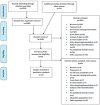Exercise Training-Induced Extracellular Matrix Protein Adaptation in Locomotor Muscles: A Systematic Review
- PMID: 33926070
- PMCID: PMC8146973
- DOI: 10.3390/cells10051022
Exercise Training-Induced Extracellular Matrix Protein Adaptation in Locomotor Muscles: A Systematic Review
Abstract
Exercise training promotes muscle adaptation and remodelling by balancing the processes of anabolism and catabolism; however, the mechanisms by which exercise delays accelerated muscle wasting are not fully understood. Intramuscular extracellular matrix (ECM) proteins are essential to tissue structure and function, as they create a responsive environment for the survival and repair of the muscle fibres. However, their role in muscle adaptation is underappreciated and underinvestigated. The PubMed, COCHRANE, Scopus and CIHNAL databases were systematically searched from inception until February 2021. The inclusion criteria were on ECM adaptation after exercise training in healthy adult population. Evidence from 21 studies on 402 participants demonstrates that exercise training induces muscle remodelling, and this is accompanied by ECM adaptation. All types of exercise interventions promoted a widespread increase in collagens, glycoproteins and proteoglycans ECM transcriptomes in younger and older participants. The ECM controlling mechanisms highlighted here were concerned with myogenic and angiogenic processes during muscle adaptation and remodelling. Further research identifying the mechanisms underlying the link between ECMs and muscle adaptation will support the discovery of novel therapeutic targets and the development of personalised exercise training medicine.
Keywords: adaptation; ageing; collagens; exercise training; extracellular matrix; glycoproteins; myogenesis; proteoglycans; remodelling; skeletal muscle.
Conflict of interest statement
The authors declare no conflict of interest.
Figures
References
-
- Neufer P.D., Bamman M.M., Muoio D.M., Bouchard C., Cooper D.M., Goodpaster B.H., Booth F.W., Kohrt W.M., Gerszten R.E., Mattson M.P., et al. Understanding the Cellular and Molecular Mechanisms of Physical Activity-Induced Health Benefits. Cell Metab. 2015;22:4–11. doi: 10.1016/j.cmet.2015.05.011. - DOI - PubMed
Publication types
MeSH terms
Substances
LinkOut - more resources
Full Text Sources
Other Literature Sources
Medical



